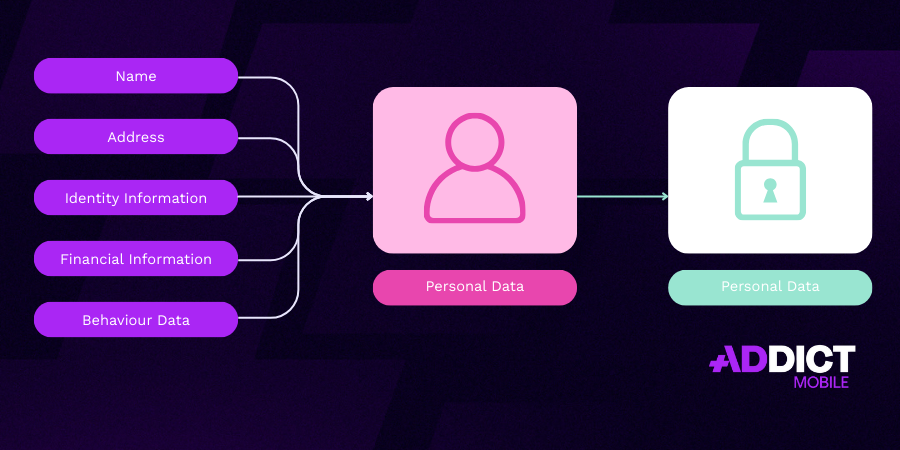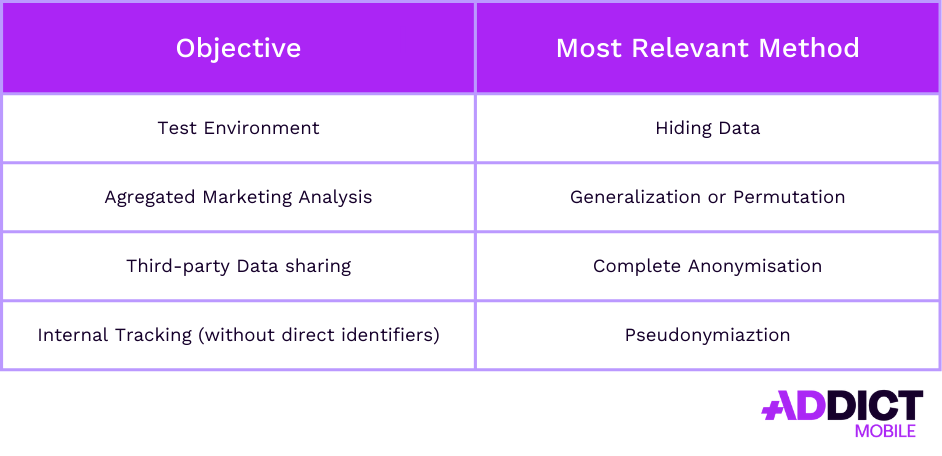Data Anonymization: Challenges, Methods, and Impact in App Marketing
Introduction
In the digital age, user data is a valuable—but also sensitive—resource. With growing regulatory pressure and rising expectations around privacy, data anonymization has become a central concern, especially in app marketing. But what exactly does it mean? Why is it critical? And most importantly, how can it be done without compromising campaign performance? That’s what we’ll explore in this article.
What Is Data Anonymization?
Definition
Data anonymization is the process of irreversibly transforming personal data so that it can no longer be linked to any identifiable individual. Unlike pseudonymization, re-identification is not possible.
Context
Since the implementation of the GDPR in Europe and similar regulations (such as the CCPA in California), companies are required to minimize their use of personal data and ensure its protection. Anonymization is therefore a way to comply with legal obligations while still being able to leverage certain types of data.
Which Data Needs to Be Anonymized?
Technical Identifiers
- IDFA (iOS) and GAID (Android): unique advertising identifiers
- IP address: identifies device and location
- Device identifiers (IMEI, MAC address, etc.)
Personal Data
- First and last name
- Email address
- Phone number
- Physical address
Location Data
- GPS coordinates
- Location history
- Geolocated IP address
Behavioral Data
- Browsing or app usage history
- In-app purchase or event logs
- Individual ad interactions (clicks, impressions, conversions)
Sensitive Data
- Health-related information
- Financial or payment data
- Biometric data

Why Is Data Anonymization Essential in App Marketing?
Data anonymization is crucial for app marketers not only to comply with marketing regulations, but also on a broader strategic level.
Compliance With Privacy Regulations
Under GDPR and CCPA, complying with these laws is essential for business sustainability, as non-compliance can lead to legal penalties and fines. Anonymization makes it possible to operate legally, even without explicit user consent, depending on the type and treatment of collected data.
Protection of Personal Data
Anonymization eliminates the risk of user re-identification and data leaks. This helps prevent unauthorized data use and reduces liability associated with managing personal information. This is especially important in sensitive sectors like health or finance.
Stronger User Relationships
In a privacy-first world, respecting user privacy positively impacts trust in the app and brand. Emphasizing transparency and ethics strengthens the bond between app developers and their users—and can boost revenue over time.
Reduced Need for Explicit Consent
Certain types of analysis don’t require user consent, provided the data is sufficiently anonymized (e.g., browsing data). Avoiding consent requests during onboarding or usage can reduce friction and improve user retention.
Simplified Analysis and Data Sharing
Anonymized data allows for robust statistical analysis, which can be shared with marketing partners (agencies, DSPs, MMPs, CDPs) without compromising privacy, thus enabling smooth and effective campaign execution.
Adapting to New Platform Rules
Anonymization also addresses new privacy expectations set by Apple (App Tracking Transparency) and Android’s Privacy Sandbox, encouraging advertisers to adopt alternative attribution methods such as probabilistic models or SKAN.
How to Anonymize Data?
There are several ways to make users unidentifiable to advertising platforms. Here are some of the main techniques:
Data Masking
Replaces sensitive data with random characters or dummy values (e.g., replacing an email with “xxxxx@xxxxx.com”). Ideal for testing environments. One of the most common and secure techniques.
Data Pseudonymization
Replaces direct identifiers (e.g., name) with pseudonyms. It reduces risk but does not fully anonymize the data, since re-identification remains possible using a key.
Data Generalization
Reduces the precision of a data point (e.g., replacing “Paris, Street X” with “Île-de-France”). Useful for analyzing regional trends.
Data Permutation
Shuffles data between users. For instance, location identifiers may be swapped between users to obscure identities.
Which Method & When?

What Challenges Does This Pose for Marketers?
It’s clear that data anonymization brings challenges for marketers who rely on detailed information to fuel their strategies.
Loss of Granularity and Personalization
Anonymized data makes it impossible to individually target or retarget users, limiting personalization in ads and user experiences. Strategies based on behavioral data (like dynamic retargeting) lose effectiveness.
Difficulties in Performance Measurement
Attribution becomes more complex or even impossible without historic identifiers like IDFA or GAID, making it harder to map the full user journey. Alternative attribution methods—such as SKAN, probabilistic models, or Marketing Mix Modeling—are needed.
Additional Technical Resources Required
Data anonymization requires technical expertise and resources. Data teams need robust, reliable tools to manage the complexities of data flows (collection, processing, storage, and sharing). This also implies reworking analytical and reporting processes, which can impact operational efficiency.
Less Agility in Optimization
Collecting feedback takes longer, which impacts campaign responsiveness. Marketers may struggle to detect weak signals or identify high-performing channels in real time.
Organizational and Strategic Implications
Traditional data-driven strategies lose impact, forcing marketing teams to shift from hyper-targeted approaches to more contextual or segmented strategies.

Do not hesitate to contact with our teams
Addict can support you to improve your performance.
What Solutions Help Maintain Campaign Performance?
Though anonymization may limit the performance of some strategies, marketers can still thrive by adopting the following approaches:
Work With Aggregated Data
Instead of individual-level data, focus on statistical insights by grouping users into cohorts or audience segments to observe broader trends. For instance, analyze 7-day retention or average LTV to predict future purchases.
Intégrez des outils privacy-first
At Addict Mobile, we strongly recommend using MMPs that support SKAN / Privacy Sandbox, such as Adjust, Appsflyer or Singular. These tools offer reliable BI capabilities while complying with GDPR and anonymization constraints.
Adopt Alternative Attribution Methods
Anonymized data means fewer insights into the user journey. Therefore, adopting new attribution methods is critical. MMM (Marketing Mix Modeling), for example, helps measure the global impact of campaigns without identifiers. Incrementality testing is also a relevant solution to isolate the real impact of a campaign versus a control group.
Use Contextual Targeting
Contextual targeting—based on app type, category, or time of day—allows marketers to reach users more effectively without needing to identify them. It adapts to the available device-level signals.
Leverage First-Party Data
First-party data—shared by users with informed consent—remains highly valuable. Encourage account creation, logins, and smart opt-ins to collect this type of information. The result? High-quality data that can be activated in secure environments (CRM, owned media campaigns, etc.).
Create Engaging Ad Experiences
With reduced access to user data, creativity becomes even more crucial to compensate for limited targeting. Use large-scale creative testing with automation tools (like Creathor). Experiment with different formats, angles, and concepts to reduce ad fatigue.
Collaborate Closely With Partners
Alone you go faster, but together you go further! Working hand in hand with DSPs, Ad Networks, and Publishers helps boost campaign efficiency in a data-restricted environment. Make sure to negotiate solid data-sharing agreements while remaining compliant with regulations.
Conclusion
L’anonymisation des données n’est pas une contrainte, mais une opportunité d’innover tout en respectant la vie privée des utilisateurs. Pour les marketeurs, cela implique de revoir certaines pratiques, mais aussi d’adopter des outils et des approches plus responsables et stratégiques. Car demain, la performance passera aussi par la confiance.


